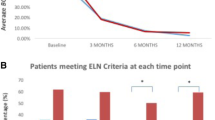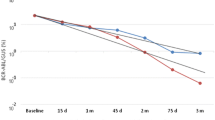Abstract
Purpose
The genomic break on the major breakpoint cluster region of chromosome 22 results in two BCR-ABL1 transcripts of different sizes, e14a2 and e13a2. Favorable survival probabilities of patients with chronic myeloid leukemia (CML) in combination with too small patient samples may yet have obstructed the observation of differences in overall survival of patients according to transcript type. To overcome potential power problems, overall survival (OS) probabilities and probabilities of CML-related death were analyzed in 1494 patients randomized to first-line imatinib treatment.
Methods
OS probabilities and probabilities of dying of CML were compared using the log-rank or Gray test whichever was appropriate. Both tests were stratified for the EUTOS long-term survival score.
Results
Between the groups with a single transcript, neither OS probabilities (stratified log-rank test: p = 0.106) nor probabilities of CML-related death were significantly different (stratified Gray test: p = 0.256). Regarding OS, the Cox hazard ratio (HR) of transcript type e13a2 (n = 565) to type e14a2 (n = 738) was 1.332 (95% CI 0.940–1.887). Considering probabilities of leukemia-related death, the corresponding subdistribution HR resulted in 1.284 (95% CI 0.758–2.176). Outcome did not change if patients with both transcripts (n = 191) were added to the 738 with type e14a2 only.
Conclusions
The prognostic association of transcript type and long-term survival outcome was weak and without clinical relevance. However, earlier reported differences in the rate and the depth of molecular response could be relevant for the chance of successfully discontinuing TKI treatment. The effect of transcript type on molecular relapse after discontinuation is unknown, yet.




Similar content being viewed by others
References
Baccarani M, Deininger MW, Rosti G, Hochhaus A, Soverini S, Apperley JF, Cervantes F, Clark RE, Cortes JE, Guilhot F, Hjorth-Hansen H, Hughes TP, Kantarjian HM, Kim D-W, Larson RA, Lipton JH, Mahon F-X, Martinelli G, Mayer J, Müller MC, Niederwieser D, Pane F, Radich JP, Rousselot P, Saglio G, Saußele S, Schiffer C, Silver R, Simonsson B, Steegmann J-L, Goldman JM, Hehlmann R (2013) European LeukemiaNet recommendations for the management of chronic myeloid leukemia: 2013. Blood 122(6):872–884. doi:10.1182/blood-2013-05-501569
Bocchia M, Gentili S, Abruzzese E, Fanelli A, Iuliano F, Tabilio A, Amabile M, Forconi F, Gozzetti A, Raspadori D, Amadori S, Lauria F (2005) Effect of a p210 multipeptide vaccine associated with imatinib or interferon in patients with chronic myeloid leukaemia and persistent residual disease: a multicentre observational trial. Lancet 365(9460):657–662. doi:10.1016/S0140-6736(05)17945-8
Bonifacio M, Scaffidi L, Binotto G, De Marchi F, Maino E, Calistri E, Bonalumi A, Frison L, Marin L, Medeot M, De Matteis G, Fanin R, Semenzato G, Ambrosetti A, Tiribelli M (2015) Predictive factors of stable deep molecular response in chronic myeloid leukemia patients treated with standard dose imatinib: a study from the “Gruppo Triveneto LMC”. Blood 126(23):597 (abstract)
Brauer KM, Werth D, von Schwarzenberg K, Bringmann A, Kanz L, Grunebach F, Brossart P (2007) BCR-ABL activity is critical for the immunogenicity of chronic myelogenous leukemia cells. Cancer Res 67(11):5489–5497. doi:10.1158/0008-5472.CAN-07-0302
Castagnetti F, Gugliotta G, Palandri F, Breccia M, Stagno F, Levato L, Fava C, Luciano L, Intermesoli T, Cedrone M, Carella AM, Cavazzini F, Turri D, Avanzini P, Pierri I, Lunghi M, Venturi C, Soverini S, Testoni N, Alimena G, Saglio G, Martinelli G, Pane F, Baccarani M, Rosti G (2012) The BCR-ABL1 transcript type does not influence the response and the outcome of chronic myeloid leukemia patients treated frontline with nilotinib. Blood 120(21):1680 (abstract)
Choudhury JB (2002) Non-Parametric confidence interval estimation for competing risks analysis: application to contraceptive data. Stat Med 21:1129–1144
Fine JP, Gray RJ (1999) A proportional hazards model for the subdistribution of a competing risk. J Am Stat Assoc 94(446):496–509
Gray RJ (1988) A class of k-sample tests for comparing the cumulative incidence of a competing risk. Ann Stat 16(3):1141–1154
Hanfstein B, Lauseker M, Hehlmann R, Saussele S, Erben P, Dietz C, Fabarius A, Proetel U, Schnittger S, Haferlach C, Krause SW, Schubert J, Einsele H, Hanel M, Dengler J, Falge C, Kanz L, Neubauer A, Kneba M, Stegelmann F, Pfreundschuh M, Waller CF, Spiekermann K, Baerlocher GM, Pfirrmann M, Hasford J, Hofmann WK, Hochhaus A, Muller MC, Sakk, the German CMLSG (2014) Distinct characteristics of e13a2 versus e14a2 BCR-ABL1 driven chronic myeloid leukemia under first-line therapy with imatinib. Haematologica 99(9):1441–1447. doi:10.3324/haematol.2013.096537
Haskovec C, Ponzetto C, Polak J, Maritano D, Zemanova Z, Serra A, Michalova K, Klamova H, Cermak J, Saglio G (1998) P230 BCR/ABL protein may be associated with an acute leukaemia phenotype. Br J Haematol 103(4):1104–1108
Hochhaus A, Reiter A, Skladny H, Melo JV, Sick C, Berger U, Guo JQ, Arlinghaus RB, Hehlmann R, Goldman JM, Cross NC (1996) A novel BCR-ABL fusion gene (e6a2) in a patient with Philadelphia chromosome-negative chronic myelogenous leukemia. Blood 88(6):2236–2240
Hoffmann VS, Baccarani M, Hasford J, Castagnetti F, Di Raimondo F, Casado LF, Turkina A, Zackova D, Ossenkoppele G, Zaritskey A, Hoglund M, Simonsson B, Indrak K, Sninska Z, Sacha T, Clark R, Bogdanovic A, Hellmann A, Griskevicius L, Schubert-Fritschle G, Sertic D, Guilhot J, Lejniece S, Zupan I, Burgstaller S, Koskenvesa P, Everaus H, Costeas P, Lindoerfer D, Rosti G, Saussele S, Hochhaus A, Hehlmann R (2016) Treatment and outcome of 2904 CML patients from the EUTOS population-based registry. Leukemia. doi:10.1038/leu.2016.246
Jain P, Kantarjian H, Patel KP, Gonzalez GN, Luthra R, Kanagal Shamanna R, Sasaki K, Jabbour E, Romo CG, Kadia TM, Pemmaraju N, Daver N, Borthakur G, Estrov Z, Ravandi F, O’Brien S, Cortes J (2016) Impact of BCR-ABL transcript type on outcome in patients with chronic-phase CML treated with tyrosine kinase inhibitors. Blood 127(10):1269–1275. doi:10.1182/blood-2015-10-674242
Kalbfleisch JD, Prentice RL (1980) The statistical analysis of failure time data. Wiley, New York
Lucas CM, Harris RJ, Giannoudis A, Davies A, Knight K, Watmough SJ, Wang L, Clark RE (2009) Chronic myeloid leukemia patients with the e13a2 BCR-ABL fusion transcript have inferior responses to imatinib compared to patients with the e14a2 transcript. Haematologica 94(10):1362–1367. doi:10.3324/haematol.2009.009134
Melo JV (1996) The diversity of BCR-ABL fusion proteins and their relationship to leukemia phenotype. Blood 88(7):2375–2384
Molica M, Zacheo I, Diverio D, Alimena G, Breccia M (2015) Long-term outcome of chronic myeloid leukaemia patients with p210 and p190 co-expression at baseline. Br J Haematol 169(1):148–150. doi:10.1111/bjh.13184
Pfirrmann M, Lauseker M, Hoffmann VS, Hasford J (2015) Prognostic scores for patients with chronic myeloid leukemia under particular consideration of competing causes of death. Ann Hematol 94(Suppl 2):S209–S218. doi:10.1007/s00277-015-2316-0
Pfirrmann M, Baccarani M, Saussele S, Guilhot J, Cervantes F, Ossenkoppele G, Hoffmann VS, Castagnetti F, Hasford J, Hehlmann R, Simonsson B (2016) Prognosis of long-term survival considering disease-specific death in patients with chronic myeloid leukemia. Leukemia 30(1):48–56. doi:10.1038/leu.2015.261
Ravandi F, Cortes J, Albitar M, Arlinghaus R, Qiang Guo J, Talpaz M, Kantarjian HM (1999) Chronic myelogenous leukaemia with p185(BCR/ABL) expression: characteristics and clinical significance. Br J Haematol 107(3):581–586
The Italian Cooperative Study Group on Chronic Myeloid Leukemia (1995) Chronic myeloid leukemia, BCR/ABL transcript, response to interferon, and survival. Leukemia 9(10):1648–1652
Therneau TM, Grambsch PM (2000) Modeling survival data: extending the cox model. Springer, New York
van Rhee F, Hochhaus A, Lin F, Melo JV, Goldman JM, Cross NC (1996) p190 BCR-ABL mRNA is expressed at low levels in p210-positive chronic myeloid and acute lymphoblastic leukemias. Blood 87(12):5213–5217
Verma D, Kantarjian HM, Jones D, Luthra R, Borthakur G, Verstovsek S, Rios MB, Cortes J (2009) Chronic myeloid leukemia (CML) with P190 BCR-ABL: analysis of characteristics, outcomes, and prognostic significance. Blood 114(11):2232–2235. doi:10.1182/blood-2009-02-204693
Acknowledgements
The valuable assistance of Annett Schmitt and Kirsi Manz is gratefully appreciated. The EUTOS was a common project of the European LeukemiaNet and Novartis Oncology Europe. Novartis Oncology Europe provided financial support for the EUTOS project between 2007 and 2015. This publication is the sole responsibility of the authors, who have complete access to the data.
Author information
Authors and Affiliations
Corresponding author
Ethics declarations
Conflict of interest
The EUTOS project was started as a common enterprise of the European LeukemiaNet and Novartis Oncology Europe. Novartis Oncology Europe provided financial support for the EUTOS project between 2007 and 2015. Susanne Saussele received honoraria from Novartis, Bristol-Myers Squibb, Pfizer, and ARIAD as well as research support from Novartis and Bristol-Myers Squibb. Fausto Castagnetti both received honoraria from and acted as a consultant for Novartis, Bristol-Myers Squibb, Incyte, and Pfizer. Francisco Cervantes was part of the advisory board of Novartis, ARIAD, and Pfizer and of the speaker’s bureau of Novartis, Bristol-Myers Squibb, ARIAD, and Pfizer. Jeroen Janssen declared speaker’s fees from Bristol-Myers Squibb and Pfizer and was part of the advisory board of ARIAD. Jeroen Janssen also received research funding from Novartis. Gabriele Gugliotta reported speaker’s fees from Novartis and Bristol-Myers Squibb. Andreas Hochhaus received research support by Novartis, BMS, Pfizer, and ARIAD. Michele Baccarani acted as a consultant for and received speaker’s fee from Novartis, Bristol-Myers Squibb, ARIAD, and Pfizer. Markus Pfirrmann, Dobromira Evtimova, Verena S. Hoffmann, Rüdiger Hehlmann, and Joerg Hasford declare no conflict of interest.
Ethical approval
All procedures performed in studies involving human participants were in accordance with the ethical standards of the institutional and/or national research committee and with the 1964 Helsinki declaration and its later amendments or comparable ethical standards. All studies were approved by the local human investigations committee and performed in accordance with the legal requirements of the corresponding country. Informed consent was obtained from all individual participants included in the study.
Rights and permissions
About this article
Cite this article
Pfirrmann, M., Evtimova, D., Saussele, S. et al. No influence of BCR-ABL1 transcript types e13a2 and e14a2 on long-term survival: results in 1494 patients with chronic myeloid leukemia treated with imatinib. J Cancer Res Clin Oncol 143, 843–850 (2017). https://doi.org/10.1007/s00432-016-2321-2
Received:
Accepted:
Published:
Issue Date:
DOI: https://doi.org/10.1007/s00432-016-2321-2




